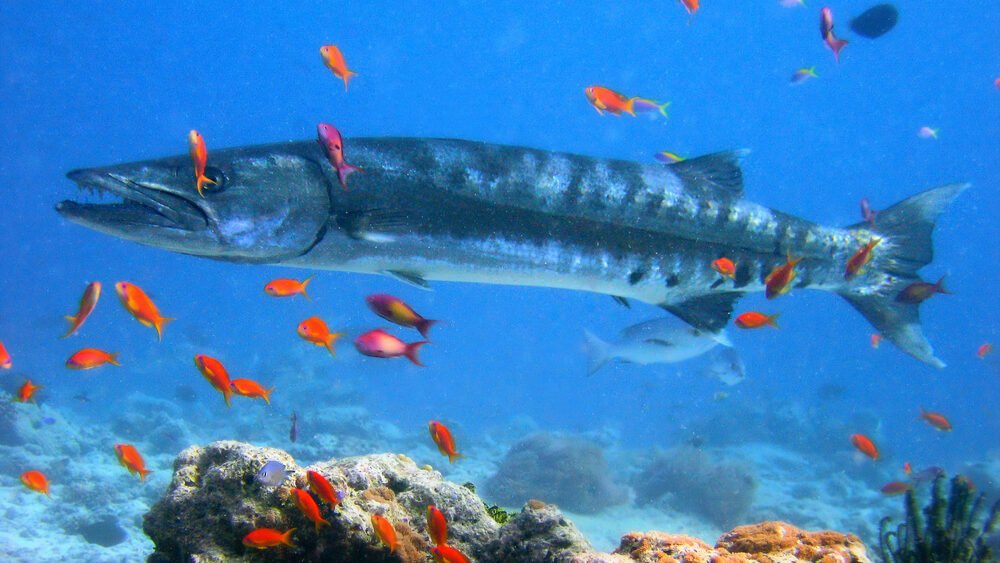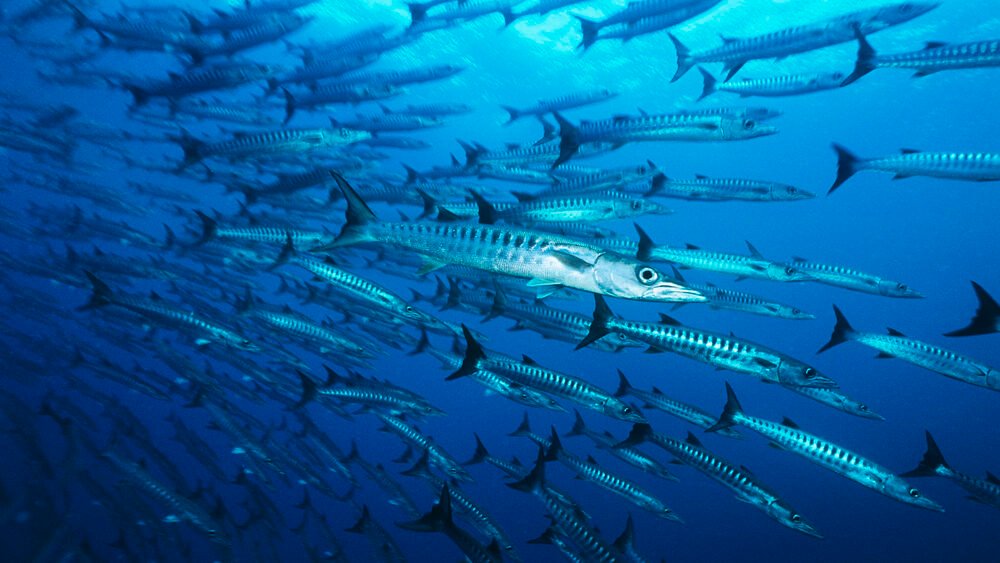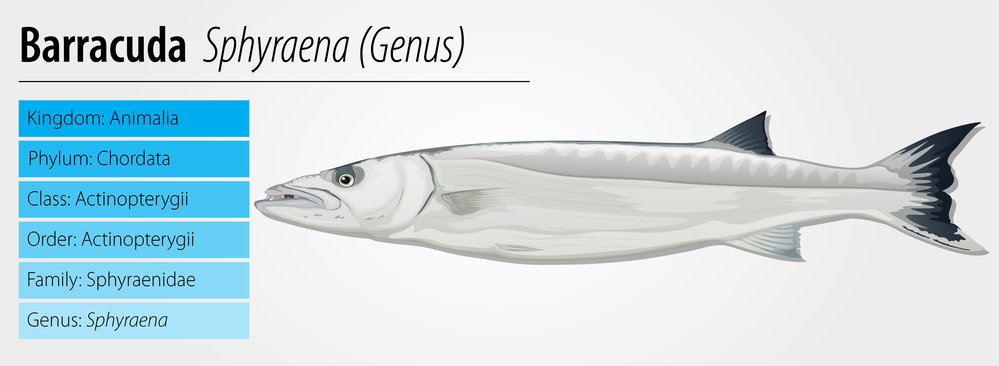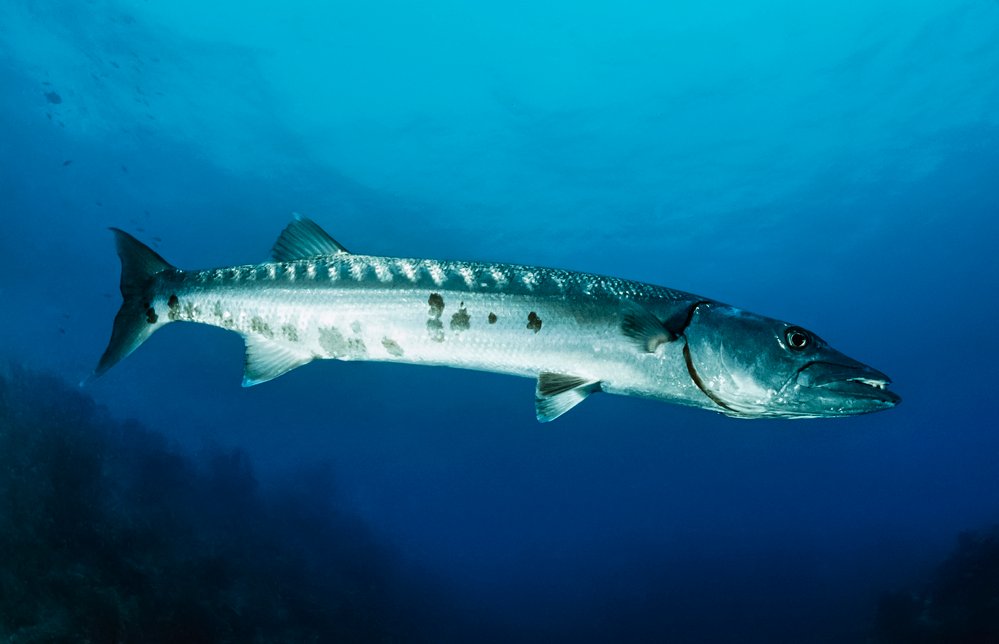Sphyraena Barracuda Fish Fun Facts, Habitat, Predators, Food & FAQ
Barracuda (Sphyraena Barracuda) is a large predatory fish that lives in tropical waters worldwide. It has a long and thin body with large jaws and sharp teeth.
Quick Barracuda Fish Facts

Here are some fun facts:
- Barracuda are scientifically known as Sphyraena Barracuda.
- Barracudas live in tropical and subtropical waters around the world.
- They are fast swimmers and can swim 36 miles or 58 kilometers per hour.
- You can recognize their slim, torpedo-like shape, large eyes, and long, tapered snout.
- They are gray, green, white, or blue on their upper body, have silvery-colored sides, shiny scales, and have a white belly.
- Some species of barracuda can grow up to 5 feet and 5 inches in length, or 165 cm, and weigh up to 20 pounds or 9 kg.
- They have impressive sharp teeth, making them capable predators in the wild.
- These predators feed on small fish, squid, octopus, and crustaceans.
- 29 known species of barracudas inhabit different parts of the ocean.
- These fish are essential to commercial fisheries due to their high food and sport fishing demand.
- They have sharp teeth but usually, leave humans alone unless threatened or provoked.
- Their lifespan is 14 years.
Barraduca Fish Habitat

The Barracuda fish is a species that inhabits marine environments in tropical and subtropical regions worldwide. Often found in the Atlantic, Caribbean, and Pacific oceans and the Red Sea.
You have the most chance of finding it in shallow, warm waters near coral reefs, sea grass, mangroves, and estuaries. It lives near the surface of the sea and typically does not dive below 110 meters deep.
They prefer areas with plenty of vegetation, such as seagrass beds, which provide them with food and shelter, and they can use the seagrass as a hiding place to wait for potential prey and ambush them.
To survive, they need clean water with adequate oxygen levels; therefore, they are sensitive to environmental changes caused by pollution or overfishing.
Great Barracuda Behavior
The Great Barracuda Fish has highly aggressive behavior but mostly won’t attack humans without provocation. Due to their small size and the fact that barracuda attacks are rare, they are not considered dangerous to humans.
The species are primarily solitary animals, but smaller barracudas may form small schools when hunting for food or protecting themselves from predators.
In hunting schools, they will use herding and corralling strategies to catch prey. Especially their strong fins are helpful when the barracuda attacks, as it darts toward its target at high speeds before snapping it with its two rows of teeth.
Barracuda Reproduction and Lifespan

The barracuda is a fish that reproduces by laying eggs in the water. They usually spawn during the summer, between May and August, when the water temperature is warmest.
The female may lay 50,000 eggs, but older Pacific barracudas can lay up to 200,000 to 400,000 eggs.
After spawning, the eggs remain buoyant in the water column until they hatch.
The lifespan of the barracuda varies greatly depending on the species; some can live up to 20 years, while others may only live up to five years.
Generally speaking, their life expectancy can be anywhere from 5-15 years in captivity, while in the wild, they may live much longer due to better living conditions and more food sources.
Barracuda Predators and Prey
Since the fish is a skilled predator with great speed, it is not easy prey and doesn’t have many natural predators of its own. The few predators are larger barracudas and larger fish such as tuna, goliath groupers, dolphins, orcas, and sharks.
Typically they swim alone or in small groups, but some of the species are schooling species that swim in large groups to protect against predators.
As for their prey, the barracuda is an omnivore that enjoys feasting on smaller fish, such as jacks, snapper, grouper, small tuna, killifish, herring, grunt, herring, and anchovies. They may also feed on cephalopods such as squid and octopus.
Barracudas usually hunt alone or in small groups while they look for food and use their sharp, fang-like teeth to catch their prey and kill them quickly and efficiently. They either swallow their prey whole or bite them into a few pieces.
As both a predator and prey, the barracuda is an integral part of the ocean ecosystem.
Barracuda Fish Conservation and Sustainability

Conservation and sustainability are vital for this species’ future. Barracuda fish numbers have decreased due to overfishing, habitat threats, and pollution. For example, it is considered vulnerable in Florida due to its narrow habitat range and sensitivity to environmental changes.
We can protect barracudas by establishing sustainable fishing practices to create sustainable fisheries, reduce pollution, and set quotas and limits for catch and size. Use sustainable fishing techniques, catch and release, and avoid nets and seines to reduce overfishing and bycatch.
By following sustainable fishing practices, we can conserve a balanced population for the species and preserve it for future generations.
Barracuda as food and nutrition
If you’re looking for tasty, healthy fish to add to your meal, look no further than the barracuda!
These lean, mean swimming machines are packed with protein and low in fat, making them an excellent choice for anyone looking to stay healthy.
And they’re not just good for your body but are loaded with minerals like calcium, phosphorus, and vitamins A and D.
Plus, they’ve got plenty of omega-3 fatty acids, known to have all sorts of health benefits.
Barracuda is a delicious addition to any meal, whether you grill it, bake it, or fry it up. Just remember the veggies on the side!
Barracuda Scientific Name, Taxonomy, and Classification

Family: Sphyraenidae (Barracudas) Order: Perciformes (Perch and Allied Fish) Class: Actinopterygii (Ray-finned Fish)
- Kingdom: Animalia
- Phylum: Chordata
- Class: Actinopterygii (ray-finned fish)
- Order: Istiophoriformes (bony fish)
- Family: Sphyraenidae (Barracudas)
- Genus: Sphyraena
There are many species of barracuda, and currently 29 species in the genus Sphyraena:
- Sphyraena acutipinnis (Sharpfin barracuda)
- Sphyraena afra (Guinean barracuda)
- Sphyraena arabiansis (Arabian barracuda)
- Sphyraena argentea (Pacific barracuda)
- Sphyraena barracuda (Great barracuda)
- Sphyraena borealis (Northern sennet)
- Sphyraena chrysotaenia (Yellowstripe barracuda)
- Sphyraena ensis (Mexican barracuda)
- Sphyraena flavicauda (Yellowtail barracuda)
- Sphyraena forsteri (Bigeye barracuda)
- Sphyraena guachancho (Guachanche barracuda)
- Sphyraena helleri 1 (Heller’s barracuda)
- Sphyraena iburiensis
- Sphyraena idiastes (Pelican barracuda)
- Sphyraena intermedia
- Sphyraena japonica (Japanese barracuda)
- Sphyraena jello (Pickhandle barracuda)
- Sphyraena lucasana (Lucas barracuda)
- Sphyraena novaehollandiae (Australian barracuda)
- Sphyraena obtusata (Obtuse barracuda)
- Sphyraena picudilla (Southern sennet)
- Sphyraena pinguis (Red barracuda)
- Sphyraena putnamae (Sawtooth barracuda)
- Sphyraena qenie (Blackfin barracuda)
- Sphyraena sphyraena (European barracuda)
- Sphyraena tome
- Sphyraena viridensis (Yellowmouth barracuda)
- Sphyraena waitii
Frequently Asked Questions about Barracudas
Is barracuda fish good to eat?

People are advised not to eat barracudas longer than 3.5 feet because of the possibility of toxins and Ciguatera fish poisoning.
Ciguatoxins can cause illness, diarrhea, vomiting, dizziness, and other symptoms.
Are barracuda fish poisonous?

The fish is not poisonous, but their flesh can be contaminated and linked to Ciguatera poisoning.
Plankton produces Ciguatera, and other marine animals later consume the plankton, and their flesh bioaccumulates ciguatoxins.
Do barracudas attack humans?

Barracudas rarely attacks humans. But in some instances they have been observed to follow snorkelers and divers. The fish is normally not interested in feeding on humans, but may confuse shiny objects such as a diver’s knife or a metal watch to be a meal, since it looks like the shiny scales of a fish.

